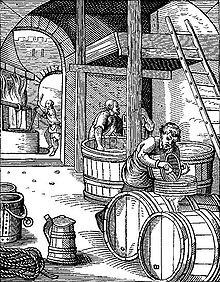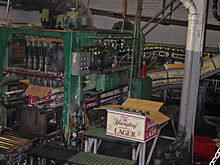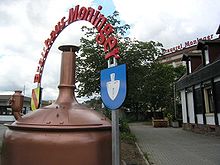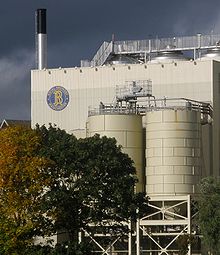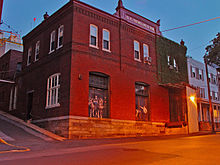- Brewery
-
 Kettles in a modern Trappist brewery
Kettles in a modern Trappist brewery
A brewery is a dedicated building for the making of beer, though beer can be made at home, and has been for much of beer's history. A company which makes beer is called either a brewery or a brewing company.
The diversity of size in breweries is matched by the diversity of processes, degrees of automation, and kinds of beer produced in breweries. Typically a brewery is divided into distinct sections, with each section reserved for one part of the brewing process.
Contents
History
See also: History of beerThe oldest brewery in the world is believed to be the German state-owned Weihenstephan brewery in the city of Freising, Bavaria. It can trace its history back to 1040 AD (this is disputed by the nearby Weltenburg Abbey brewery, who can trace back its beer-brewing tradition to at least 1050 AD, claiming the Weihenstephan document is at least controversial. The Zatec brewery in the Czech Republic claims it can prove that it paid a beer tax in 1004 AD).
The industrialization of the brewery
Beer, in some form, can be traced back almost 5000 years to Mesopotamian writings describing daily rations of beer and bread to workers. Before the rise of production breweries, the production of beer took place at home and was the domain of women, as baking and brewing were seen as "women's work". Breweries, as production facilities reserved for making beer, did not emerge until monasteries and other Christian institutions started producing beer not only for their own consumption, but also to use as payment. This industrialization of brewing shifted the responsibility of making beer to men.
Early breweries were almost always built on multiple stories, with equipment on higher floors used earlier in the production process, so that gravity could assist with the transfer of product from one stage to the next. This layout often is preserved in breweries today, but mechanical pumps allow more flexibility in brewery design.
Early breweries typically used large copper vats in the brewhouse, and fermentation and packaging took place in lined wooden containers. Such breweries were common until the Industrial Revolution, when better materials became available, and scientific advances led to a better understanding of the brewing process. Today, almost all brewery equipment is made of stainless steel.
Major technological advances
A handful of major breakthroughs have led to the modern brewery and its ability to produce the same beer consistently.
The steam engine, vastly improved in 1765 by James Watt, brought automatic stirring mechanisms and pumps into the brewery. It gave brewers the ability to mix liquids more reliably while heating, particularly the mash, to prevent scorching, and a quick way to transfer liquid from one container to another. Almost all breweries now use electric-powered stirring mechanisms and pumps. The steam engine also allowed the brewer to make greater quantities of beer, as human power was no longer a limiting factor in moving and stirring.
Carl von Linde, along with others, is credited with developing the refrigeration machine in 1871. Refrigeration allowed beer to be produced year-round, and always at the same temperature. Yeast is very sensitive to temperature, and if a beer was produced during summer, the yeast would impart unpleasant flavors onto the beer. Most brewers would produce enough beer during winter to last through the summer, and store it in underground cellars, or even caves, to protect it from summer's heat.
Most importantly, the discovery of microbes by Louis Pasteur was instrumental in the control of fermentation. The idea that yeast was a microorganism that worked on wort to produce beer led to the isolation of a single yeast cell by Emil Christian Hansen. Pure yeast cultures allow brewers to pick out yeasts for their fermentation characteristics, including flavor profiles and fermentation ability. Some breweries in Belgium, however, still rely on "spontaneous" fermentation for their beers (see lambic).
The modern brewery
Breweries today are made predominantly of stainless steel, although vessels often have a decorative copper cladding for a nostalgic look. Stainless steel has many favorable characteristics which make it a well-suited material for brewing equipment. It imparts no flavor in beer, it reacts with very few chemicals, which means almost any cleaning solution can be used on it (concentrated chlorine bleach being a notable exception) and it is very sturdy. Sturdiness is important, as most tanks in the brewery have positive pressure applied to them as a matter of course, and it is not unusual that a vacuum will be formed incidentally during cleaning.
Heating in the brewhouse usually is achieved through pressurized steam, although direct-fire systems are not unusual in small breweries. Similarly, cooling in other areas of the brewery is typically done by cooling jackets on tanks, which allow the brewer to control precisely the temperature on each tank individually, although whole-room cooling is also common.
Today modern brewing plants perform myriad analyses on their beers for quality control purposes. Shipments of ingredients are analyzed to correct for variations. Samples are pulled at almost every step and tested for oxygen content, unwanted microbial infections, and other beer-aging compounds. A representative sample of the finished product often is stored for months for comparison, when complaints are received.
Brewing process
Main article: BrewingWork in the brewery is typically divided into 9 steps: Malting, Milling, Mashing, Lautering, Boiling, Fermenting, Conditioning, Filtering, and Filling.
Mashing is the process of mixing milled grain (typically malted grain) with water, and heating this mixture up with rests at certain temperatures to allow enzymes in the malt to break down the starch in the grain into sugars, typically maltose.
Lautering is the separation of the extracts won during mashing from the spent grain to create wort. It is achieved in either a lauter tun, a wide vessel with a false bottom, or a mash filter, a plate-and-frame filter designed for this kind of separation. Lautering has two stages: first wort run-off, during which the extract is separated in an undiluted state from the spent grains, and sparging, in which extract which remains with the grains is rinsed off with hot water.
Boiling the wort ensures its sterility, and thus prevents infections. During the boil, hops are added, which contribute their bitterness, aroma and flavor compounds to the beer. Along with the heat of the boil, they cause proteins in the wort to coagulate and the pH of the wort to fall, and they inhibit the later growth of certain bacteria. Finally, the vapors produced during the boil volatilize off-flavors, including dimethyl sulfide precursors.
The boil must be conducted so that it is even and intense. The boil lasts between 60 and 120 minutes, depending on its intensity, the hop addition schedule, and volume of wort the brewer expects to evaporate.
Fermenting
Fermentation, as a step in the brewing process, starts as soon as yeast is added to the cooled wort. This is also the point at which the product is first called beer. It is during this stage that fermentable sugars won from the malt (maltose, maltotriose, glucose, fructose and sucrose) are metabolized into alcohol and carbon dioxide. Fermentation tanks come in all sorts of forms, from enormous cylindroconical vessels which can look like storage silos, to five gallon glass carboys in a homebrewer's closet.
Most breweries today use cylindroconical vessels, or CCVs, which have a conical bottom and a cylindrical top. The cone's aperture is typically around 70°, an angle that will allow the yeast to flow smoothly out through the cone's apex at the end of fermentation, but is not so steep as to take up too much vertical space. CCVs can handle both fermenting and conditioning in the same tank. At the end of fermentation, the yeast and other solids which have fallen to the cone's apex can be simply flushed out through a port at the apex.
Open fermentation vessels are also used, often for show in brewpubs, and in Europe in wheat beer fermentation. These vessels have no tops, which makes harvesting top-fermenting yeasts very easy. The open tops of the vessels make the risk of infection greater, but with proper cleaning procedures and careful protocol about who enters fermentation chambers, the risk can be well controlled.
Fermentation tanks are typically made of stainless steel. If they are simple cylindrical tanks with beveled ends, they are arranged vertically, as opposed to conditioning tanks which are usually laid out horizontally.
A very few breweries still use wooden vats for fermentation but wood is difficult to keep clean and infection-free and must be repitched more or less yearly.
After high kraeusen, a bung device (German: Spundapparat) is often put on the tanks to allow the CO2 produced by the yeast to naturally carbonate the beer. This bung device can be set to a given pressure to match the type of beer being produced. The more pressure the bung holds back, the more carbonated the beer becomes.
Conditioning
When the sugars in the fermenting beer have been almost completely digested, the fermentation slows down and the yeast cells will naturally start to die off and begin to settle towards the bottom of the tank at an accelerated rate.
At this stage, esp if the beer is cooled to around freezing, most of the remaining live yeast cells will quickly go into a dormant state and will also begin to settle out along with the heavier protein chains due simply to gravity and molecular dehydration.
If the fermentation tanks have cooling jackets on them, as opposed to the whole fermentation cellar being cooled, conditioning can take place in the same tank as fermentation. Otherwise separate tanks (in a separate cellar) must be employed.
On the other hand, oftentimes beers from the brewpubs will barely be conditioned if at all, what with an active yeast culture from a on-going batch simply being added to the next boil after chilling to 80 or so deg F being all that's really needed when the major objective happens to be to rapidly produce a fresh and highly palatable beer that can be easily duplicated in mass quantity.
Filtering
 The Hook Norton brewery is one of Britain's last working tower breweries (April 2006).
The Hook Norton brewery is one of Britain's last working tower breweries (April 2006).
Filtering the beer stabilizes flavor, and gives beer its polished shine and brilliance.
Not all beer will be actively filtered after the conditioning stage, as not all conditioning will even involve an actual temperature drop.
For instance, most home brewers and probably even a majority of craft breweries consider the natural gravitational settlement and coagulation of organic impurities which occurs during the (sometimes prolonged) conditioning stage to be entirely sufficient.
In localities where a tax assessment is collected by government pursuant to local laws, any additional filtration will typically be done using an active filtering system, the filtered product finally passing into a calibrated vessel for measurement just after any cold conditioning and prior to final packaging.
Filters come in many types. Many use pre-made filtration media such as sheets or candles, while others use a fine powder made of, for example, diatomaceous earth, also called kieselguhr, which is introduced into the beer and recirculated past screens to form a filtration bed.
Filters range from rough filters that remove much of the yeast and any solids (e.g. hops, grain particles) left in the beer, to filters tight enough to strain color and body from the beer. Normally used filtration ratings are divided into rough, fine and sterile. Rough filtration leaves some cloudiness in the beer, but it is noticeably clearer than unfiltered beer. Fine filtration gives a glass of beer that you could read a newspaper through, with no noticeable cloudiness. Finally, as its name implies, sterile filtration is fine enough that almost all microorganisms in the beer are removed during the filtration process.
Filling
Filling (a.k.a. "packaging") is putting the beer into the containers in which it will leave the brewery. The containers are usually bottles, cans, or kegs; sometimes bulk tanks are used for high-volume customers.
Brewing companies
Brewing companies range widely in the volume and variety of beer produced, ranging from small breweries, such as Ringwood Brewery, to massive multinational conglomerates, like SABMiller in London or Anheuser-Busch InBev, that produce hundreds of millions of barrels annually. The biggest brewer in the world is the Belgian company Anheuser-Busch InBev. Some commonly used descriptions of breweries are:
- Microbrewery–A late 20th century name for a small brewery. The term started to be replaced with craft brewer at the start of the 21st century.[citation needed]
- Brewpub–A brewery whose beer is brewed primarily on the same site from which it is sold to the public, such as a pub or restaurant. If the amount of beer that a brewpub distributes off-site exceeds 75%, it may also be described as a craft or microbrewery.
- Contract brewing company or contract brewery–A business that hires another brewery to produce its beer. The contract brewing company generally handles all of the beer's marketing, sales, and distribution, while leaving the brewing and packaging to the producer-brewery (which, confusingly, is also sometimes referred to as a contract brewer).
- Regional brewery–An established term for a brewery that supplies beer in a fixed geographical location.
- Craft brewer–A term that is replacing microbrewery. A craft brewery is a brewery which does not use adjuncts and/or is considered to make craft beer.
- Macrobrewery or Megabrewery–Terms for a large brewery, which sometimes carry a negative connotation.
- A brewmaster, or formerly braumeister, is a person who is in charge of the production of beer. The major breweries employ engineers with a Chemistry/Biotechnology background. The title of Brewmaster is given to a person after 2½ years of extra study in the art of brewing thus earning a degree equivalent to a Master's degree.
There are organisations that assist the development of brewing, such as the Seibel Institute of Technology in the USA and the Institute of Brewing and Distilling in the UK.
See also
- Breweriana, the hobby of brewery advertising collecting
- Brewing
- Homebrewing
- Hops
- Malt
References
Bibliography
- ISBN 3-921690-49-8: Technology Brewing and Malting, Wolfgang Kunze, 2004, 3rd revised edition, VLB Berlin. Available at their website
- Beertown.org Craft Brewery definitions at the bottom of the page.[dead link]
- Straub Brewery By John Schlimm, Arcadia Publishing, 2005, ISBN 0-7385-3843-4
External links
Categories:- Brewing
- Manufacturing plants
Wikimedia Foundation. 2010.

